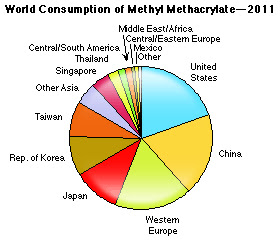I have reported about the development of biobased methyl methacrylate (MMA) only one time in November 2011 when Mitsubishi Rayon (MRC) and its subsidiary Lucite International announced that they have developed bio-based MMA, a chemical used in coatings, transparent plastics and adhesives.
This week, a start-up Minneapolis-based company called Ascenix BioTechnologies reportedly has licensed a technology from the University of Minnesota that can produce sugar-based isobutyric acid that can be then be used to further convert into MMA.
According to the University of Minnesota press release, MMA production worldwide is more than 6bn lbs/year. The problem with MMA from petroleum, the researchers said, is that it needs hydrogen cyanide which is difficult to purchase and dangerous to handle. Ascenix said this new bio-based process will be more economical and environmentally friendly.
As I’ve said, MRC has been working on bio-based MMA and is looking at two approaches for production:
- Using biomass for feedstock in the existing production processes
- Using a novel route via fermentation process of biomass
According to MRC’s website, the company currently produces MMA monomer from petrochemical feedstock using two methods: the C4 direct oxidisation process that uses isobutylene as feedstock, and the ACH (acetone cyanohydrin) process that uses acetone and hydrogen cyanide as feedstocks.
MRC and Lucite plan to start producing MMA monomer using biomass as feedstock by 2016. Long-term, MRC aims to produce at least 50% of its MMA monomer output using biomass.
Specialty chemicals firm Evonik and Arkema are also working on biobased MMA. Back in late 2011, Evonik reportedly has developed two technologies for producing their bio-MMA in pilot scale: One is its AVENEER process, which the company said is a multi-step catalytic process and more economical than conventional sulfo process. The other technology is a metabolic route using sugarcane and bacteria to generate the MMA, which can then be integrated into the AVENEER process.
Evonik reported back then that it has been working to improve the performance of the bacteria and adapt them for industrial-scale production. Evonik plans to have its bio-based MMA industrially available by 2018.
One more interesting information is that MMA can also be produced via isobutylene — so keep Gevo, DuPont, and other bio-isobutanol producers in mind. Itaconic acid is reportedly also being developed as an alternative to MMA.
As far as current MMA market is concern, IHS noted on its May 2012 report that this market is largely captive with many large producers consuming 50-60% of their production captively mainly for PMMA resins or surface coatings. World consumption of MMA reportedly grew at 3%/year during 2008-2011. Global growth consumption is forecast to average 4%/year during 2011-2016, according to IHS.
FOLLOW ME ON THESE SPACE
Has there been any new developments in this area? I have not seen much information in the news on biobased MMA.
Posted by Paul | May 21, 2014, 9:22 amSorry for the late response Paul. Bio-based MMA developments seem very slow. The only update I heard in recent months was from Novomer using CO2 and a new company called Evernu using bio-isobutanol for feedstock.
Posted by Doris de Guzman | June 3, 2014, 9:56 am